Dickensians! discussion

This topic is about
The Magic Fishbone
Short Reads, led by our members
>
The Magic Fishbone (hosted by Robin) - 2nd New Year Read 2021
date newest »
newest »
 newest »
newest »
 Welcome to this entertaining interlude! If you have located an edition with pictures, it may be portrayed in a couple of ways. Some illustrators show the family in royal clothes, while others show ordinary Victorian garb but with crowns or a few other touches.
Welcome to this entertaining interlude! If you have located an edition with pictures, it may be portrayed in a couple of ways. Some illustrators show the family in royal clothes, while others show ordinary Victorian garb but with crowns or a few other touches. We can see right away that this is no ordinary family, with 19 children, whose ages vary from 7 months to 7 years. For Dickens, who actually had 10 children, it must have seemed like 19 at times. Like many fairy tales, this one starts with a prophecy, though the person who receives it (the King) is rather dense about it.
There is a lot of talk of quarter day. Here is some info from Wikipedia:
In British and Irish tradition, the quarter days were the four dates in each year on which servants were hired, school terms started, and rents were due. They fell on four religious festivals roughly three months apart and close to the two solstices and two equinoxes.
Lady Day (25 March)
Midsummer Day (24 June)
Michaelmas (29 September)
Christmas (25 December)
In the case of our story, these days would be payday, eagerly awaited by the family.
Our heroine is the oldest girl, Alicia, who runs the house with help from the Queen and the Lord Chamberlain (Peggy.) This is an interesting glimpse into Victorian times. Middle-class and even working-class families had one or more servants. It seems there was also a cook who ran away with a soldier. Another reflection of the times is the baby falling under the grate (of the fireplace), not an accident we often deal with today.
In traditional fashion, the story follows the rule of 3, as Alicia knows that she must not use the magic fishbone until the right time. The dialogue about it with her father must be repeated 3 times.
Feel free to comment. The story can easily be read in one sitting.
message 3:
by
Bionic Jean, "Dickens Duchess"
(last edited May 17, 2021 07:31AM)
(new)
-
rated it 5 stars
Thanks Robin! I have the edition on our group bookshelf, with illustrations by Francis D. Bedford, but as I won't be able to access it in time, I've read the free Gutenberg one LINK HERE
That one has nice line drawings, and some watercolour ones, by Susan Beatrice Pearse in 1911. The style looked familar to me ... and I checked. Yes, she did all the illutrations for the Ameliaranne books! Are they known in other countries? I used to love them as a child. They are by different authors, but linked by the illustrations. So far I've just reviewed one, Ameliaranne Goes Digging, and included two illustrations in my review. Please LINK HERE if anyone would like to read it, or like to compare the illustrations with those for The Magic Fishbone. Interestingly, the concept of the Ameliaranne series is that she is a capable child, in a poor family, and looks after all her younger brothers and sisters!
I quite enjoyed the charming story of The Magic Fishbone, and found it reminiscent of Oscar Wilde's fairy stories for children - and some parts of Hans Christian Andersen too. The Gutenberg edition gives the publication history and collection details - in the USA first, which is unusual for Charles Dickens.
Which edition are you working from Robin? Is it the one you have linked to at the head of this thread?
That one has nice line drawings, and some watercolour ones, by Susan Beatrice Pearse in 1911. The style looked familar to me ... and I checked. Yes, she did all the illutrations for the Ameliaranne books! Are they known in other countries? I used to love them as a child. They are by different authors, but linked by the illustrations. So far I've just reviewed one, Ameliaranne Goes Digging, and included two illustrations in my review. Please LINK HERE if anyone would like to read it, or like to compare the illustrations with those for The Magic Fishbone. Interestingly, the concept of the Ameliaranne series is that she is a capable child, in a poor family, and looks after all her younger brothers and sisters!
I quite enjoyed the charming story of The Magic Fishbone, and found it reminiscent of Oscar Wilde's fairy stories for children - and some parts of Hans Christian Andersen too. The Gutenberg edition gives the publication history and collection details - in the USA first, which is unusual for Charles Dickens.
Which edition are you working from Robin? Is it the one you have linked to at the head of this thread?
message 4:
by
Bionic Jean, "Dickens Duchess"
(last edited Jan 17, 2021 09:29AM)
(new)
-
rated it 5 stars
I like the literary pretence of it being by a child, "Miss Alice Rainbird, aged 7", and wonder if this made it more appealing to the children of the time.
Also I liked that it follows a traditional form - Robin pointed out: the "rule of three" - and magical elements allied with a morality tale. The one hardworking child, the fairy godmother appearing in diguise, the magical talisman, the greedy person (the king) learning his lesson - amongst other things.
I did not like the final sentence - but guess Charles Dickens had to add a little bit of his grotesque sense of humour! Most of it is very whimsical :) And Charles Dickens 's strong love of children comes through - as it always does when he describes large families in his writing.
Also I liked that it follows a traditional form - Robin pointed out: the "rule of three" - and magical elements allied with a morality tale. The one hardworking child, the fairy godmother appearing in diguise, the magical talisman, the greedy person (the king) learning his lesson - amongst other things.
I did not like the final sentence - but guess Charles Dickens had to add a little bit of his grotesque sense of humour! Most of it is very whimsical :) And Charles Dickens 's strong love of children comes through - as it always does when he describes large families in his writing.
 I am using a Gutenberg version which I could read on my tablet. It is the same as the link Jean provided, with the Pearce illustrations.
I am using a Gutenberg version which I could read on my tablet. It is the same as the link Jean provided, with the Pearce illustrations. About the last sentence, when I read this book to a group of children in the past, I had to leave it out, as modern American kids would be horrified at the treatment of the dog.
One of my favorite quotes was about Prince Certainpersonio, who was "waiting to be ninety".
 If any US readers grew up in the 50's-60's, you might remember a TV series called something like "Shirley Temple Theater". The grownup Shirley Temple was the host and they did dramas of fairy tales. I remember The Wild Swans, which was a bit scary, and The Emperor's New Clothes, which was risqué to me in showing the emperor in his underwear. I am pretty sure The Magic Fishbone was done as part of that series.
If any US readers grew up in the 50's-60's, you might remember a TV series called something like "Shirley Temple Theater". The grownup Shirley Temple was the host and they did dramas of fairy tales. I remember The Wild Swans, which was a bit scary, and The Emperor's New Clothes, which was risqué to me in showing the emperor in his underwear. I am pretty sure The Magic Fishbone was done as part of that series.
 This fairytale kinda felt like a 'none sense 'story. It had all of the usual fairytale elements...tight money, a fairy godmother, a wedding, many adorable children with the adults rather removed from the children's goings on. I could see this being told to entertain children in a meandering story illustrating the good virtue of patience with a dash of cleverness saving the day.
This fairytale kinda felt like a 'none sense 'story. It had all of the usual fairytale elements...tight money, a fairy godmother, a wedding, many adorable children with the adults rather removed from the children's goings on. I could see this being told to entertain children in a meandering story illustrating the good virtue of patience with a dash of cleverness saving the day.
 The girl/heroine turns out to be wiser and more resourceful than her father. The mother is largely absent or ill. Alicia, the Duchess/doll and the fairy all see another world than the father.
The girl/heroine turns out to be wiser and more resourceful than her father. The mother is largely absent or ill. Alicia, the Duchess/doll and the fairy all see another world than the father.
 The story has fairy tale silliness and exaggeration. It also introduces a child to the concept of poverty which can occur even when a parent is working hard. (Dickens' father was in debtor's prison when Dickens was a child.) It shows how to be helpful since everyone probably did have to help out in a 19th Century family. Princess Alicia was intelligent, kind, and responsible.
The story has fairy tale silliness and exaggeration. It also introduces a child to the concept of poverty which can occur even when a parent is working hard. (Dickens' father was in debtor's prison when Dickens was a child.) It shows how to be helpful since everyone probably did have to help out in a 19th Century family. Princess Alicia was intelligent, kind, and responsible.It's difficult to know how today's children and parents would react to the story. If I was reading it to a child, I would add that in real life, make sure to tell an adult if someone gets injured. But "The Magic Fishbone" might be fun to read in conjunction with children visiting a historic house, or cooking over a fire pit to learn how children lived in the 19th Century. We also might want to skip the last sentence of the story so the young ones don't get upset.
I also enjoyed the Pearce illustrations which look like they came out of a traditional fairy tale.
 I enjoyed The Magic Fishbone. When I read all of Dickens’ novels eons ago, I didn’t think to read his short stories too, so I’m delighted to be introduced to them now. Thank you, Robin and Jean for the introduction. I read the Gutenberg version.
I enjoyed The Magic Fishbone. When I read all of Dickens’ novels eons ago, I didn’t think to read his short stories too, so I’m delighted to be introduced to them now. Thank you, Robin and Jean for the introduction. I read the Gutenberg version.I was delighted when the King went to his office as we don’t think of kings having an office. They usually sit on thrones and tell others what to do. And we don’t think of them running out of money! It is a unique perspective for a children’s story.
I’d love to read this story to my grandchildren, but COVID makes it impossible for now. I thought of doing it over the phone, but I want to share the pictures too, so it will have to wait.
The Magic Fishbone is a great contrast to The Signal-Man.
 Of course, everything about this king, queen and court is really a middle-class life. But it's so charming the way it is expressed.
Of course, everything about this king, queen and court is really a middle-class life. But it's so charming the way it is expressed.
 I read this story before Christmas. It was one of the stories in Holiday Romance by Dickens. There are four different stories, all written from the viewpoint of children. They were a lot of fun.
I read this story before Christmas. It was one of the stories in Holiday Romance by Dickens. There are four different stories, all written from the viewpoint of children. They were a lot of fun.
 I thought this was refreshing and different from our other Dickens read. I had a smile while reading it, it does show how an adult thinks a child dreams might be.
I thought this was refreshing and different from our other Dickens read. I had a smile while reading it, it does show how an adult thinks a child dreams might be.I read a review after reading the short story where the person completely failed to understand this is a fairy tale and nonsensical, complaining on how it’s impossible to have that many children so quickly! I’m pretty sure Fairy godmothers don’t exist either (or mine had failed to show on many occasions!).
 Yes, the story asks, what would it be like if magic appeared in the ordinary world? Magic isn't unlimited, the user has to wait till the right time. What Alicia finally asked for wasn't wealth beyond reason, it was just to have quarter day arrive.
Yes, the story asks, what would it be like if magic appeared in the ordinary world? Magic isn't unlimited, the user has to wait till the right time. What Alicia finally asked for wasn't wealth beyond reason, it was just to have quarter day arrive.
message 16:
by
Bionic Jean, "Dickens Duchess"
(last edited Jan 24, 2021 05:00AM)
(new)
-
rated it 5 stars
Who else is reading this? We still have a week, and it is quite short. Easy to fit in with your other reads :)
I've mentioned the two copies I have, and would be interested in other illustrators' ideas. Robin said "Some illustrators show the family in royal clothes, while others show ordinary Victorian garb but with crowns or a few other touches."
Can anyone say which these are? Has anyone read it to youngsters? Or found they have read it to themselves?
I've mentioned the two copies I have, and would be interested in other illustrators' ideas. Robin said "Some illustrators show the family in royal clothes, while others show ordinary Victorian garb but with crowns or a few other touches."
Can anyone say which these are? Has anyone read it to youngsters? Or found they have read it to themselves?
message 17:
by
Bionic Jean, "Dickens Duchess"
(last edited Jan 30, 2021 02:50AM)
(new)
-
rated it 5 stars
So often in libraries and bookshops we find that Charles Dickens's books are classed as "children's" - and not necessarily just when they are abridged versions. It seems nonsense to me, but this is a story which can be read by any children already exposed to fairy tales, I think.
Kathleen points out that "It is a unique perspective for a children’s story", so it can also be thought of as a fractured fairy tale. I think some children would find it amusing, and good illustrations would help. Kings do not routinely wear their crowns, for instance, but only on court occasions. The sense of the ludicrous is ripe for exploitation by a good artist :)
Kathleen points out that "It is a unique perspective for a children’s story", so it can also be thought of as a fractured fairy tale. I think some children would find it amusing, and good illustrations would help. Kings do not routinely wear their crowns, for instance, but only on court occasions. The sense of the ludicrous is ripe for exploitation by a good artist :)
 The copy I have is just the story inside a cover, no publisher or copyright information or anything. It does have illustrations, all black and white. Some of them are kind of blurry. The king is always dressed in royal clothing. Princess Alicia wears a crown in some of the illustrations. It looks like the illustrations may have come from different sources.
The copy I have is just the story inside a cover, no publisher or copyright information or anything. It does have illustrations, all black and white. Some of them are kind of blurry. The king is always dressed in royal clothing. Princess Alicia wears a crown in some of the illustrations. It looks like the illustrations may have come from different sources.
 Bionic Jean wrote: "So often in libraries and bookshops we find that Charles Dickens's books are classed as "children's" - and not necessarily when they are abridged. It seems nonsense to me, but this ..."
Bionic Jean wrote: "So often in libraries and bookshops we find that Charles Dickens's books are classed as "children's" - and not necessarily when they are abridged. It seems nonsense to me, but this ..."When I used this for a program I gave on Dickens, I looked at several picture book versions but I don't remember which was which.
As far as Dickens being for children, I may have posted in another thread that when I was about 10, I bought a paperback from a grocery store bin, called "Children's Stories from Dickens". It turned out that a number of them were excerpts where children died! There was no context for any of the stories. One was about "The Marchioness". This is a nickname from The Old Curiosity Shop that is given to a servant girl. I had no idea what that was. I don't think it had The Magic Fishbone though.
 I also just read the Gutenberg link you provided, Jean. This was so much fun! I was caught up in the silliness and thought it was accurate that it would be introduced as being written by a child.
I also just read the Gutenberg link you provided, Jean. This was so much fun! I was caught up in the silliness and thought it was accurate that it would be introduced as being written by a child. Jean, you mentioned the fractured fairy tales and I think that's the perfect description. I remember when I taught school using the The True Story of the 3 Little Pigs by Jon Scieszka as an example and then the students would try to write their own stories. Children can come up with some great ideas!
I think since it was meant to be a child's writing, that adults aren't necessarily meant to appreciate all of the magical elements. I was thinking about France-Andre's comment about the reviewer saying it wasn't possible for these things to happen. Well......that's right. It's all in the imagination and to be entertaining!
 I found some delightful illustrations by S. Beatrice Pearce for The Magic Fishbone.
I found some delightful illustrations by S. Beatrice Pearce for The Magic Fishbone. Check this link:
http://www.dickenslit.com/Magic-Fishb...
Such a delightful, fanciful story and the illustrations are wonderful. I think Dickens has put into a humorous, fanciful story some lessons to be heeded in real life and agree they reflect some of his own biography. Dickens 's themes include the hardships of impoverishment, responsibility, resourcefulness, patience, problem solving, the wisdom of children, and good judgment and hard work will be rewarded. The whimsical style of writing makes these rather serious concerns humorous but also that they can be overcome. I liked the repetition of words, phrases and conversations throughout the story that made the writing almost poetical. The repetitions also added to the anticipation of when would be the right time to invoke the magical fish bones. Knowing how Dickens loved his dogs, I was surprised at the pug's demise! - but perhaps a just reward for frightening the children and causing an injury. The fairy godmother was more like a Betsy Trotwood from David Copperfield with her gruff manner, at least at first.
This is definitely an odd tale and reality must be suspended to enjoy this story. Most would think a King and Queen, being of royalty, would have all the luxuries and servants to do the menial work (Dickens does have the maid running off with a drunken suitor); and the King works at a tedious, poorly paying clerical job! And what seven year old girl gets married as does Princess Alice?? But one aspect of the fantasy I can relate to is how Princess Alice confides in her "doll duchess" - I always talked things over with my dolls as a child! How wonderful is the imagination!!
I read the e-book Dover edition (2017), a republication of the Vanguard Press 1953 edition that was illustrated by Louis Slobodkin.
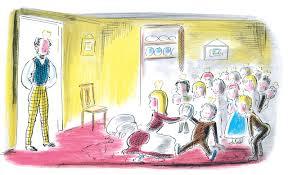
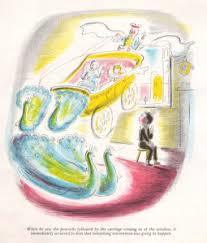
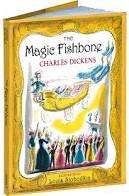
 Mystery solved. The illustrations in my book are from S. Beatrice Pearce. However, a few of the illustrations from Elizabeth's link are not in my book and the book's illustrations are all in black and white. Thank you Elizabeth.
Mystery solved. The illustrations in my book are from S. Beatrice Pearce. However, a few of the illustrations from Elizabeth's link are not in my book and the book's illustrations are all in black and white. Thank you Elizabeth.
 Katy wrote: "Mystery solved. The illustrations in my book are from S. Beatrice Pearce. However, a few of the illustrations from Elizabeth's link are not in my book and the book's illustrations are all in black ..."
Katy wrote: "Mystery solved. The illustrations in my book are from S. Beatrice Pearce. However, a few of the illustrations from Elizabeth's link are not in my book and the book's illustrations are all in black ..."😊
 Elizabeth: Thank you for the Louis Slobodkin illustrations. I've enjoyed his children's books and those he illustrated for others, including The Hundred Dresses. I didn't realize that he illustrated our Dickens book too.
Elizabeth: Thank you for the Louis Slobodkin illustrations. I've enjoyed his children's books and those he illustrated for others, including The Hundred Dresses. I didn't realize that he illustrated our Dickens book too.
 I read this & found it very different from his other works that I’ve read. Personally I found the repetitions irritating, but I imagine they are popular with young children.
I read this & found it very different from his other works that I’ve read. Personally I found the repetitions irritating, but I imagine they are popular with young children.
 Kathleen wrote: "Elizabeth: Thank you for the Louis Slobodkin illustrations. I've enjoyed his children's books and those he illustrated for others, including The Hundred Dresses. I didn't realize that ..."
Kathleen wrote: "Elizabeth: Thank you for the Louis Slobodkin illustrations. I've enjoyed his children's books and those he illustrated for others, including The Hundred Dresses. I didn't realize that ..."Yes, I immediately thought of The Hundred Dresses. I used that recently on the subject of inequality/classism.
Trisha, good point about the repetition. It's a formula of fairy and folk tales to have 3 of things, for instance. Interestingly, A Christmas Carol also uses 3 visits, but they are each distinct.
message 27:
by
Bionic Jean, "Dickens Duchess"
(last edited Jan 29, 2021 03:48PM)
(new)
-
rated it 5 stars
Thanks Elizabeth for the extra link to the illustrations by Susan Beatrice Pearse, which are the ones in the Gutenberg edition I talked about (and the illustrator for the Ameliaranne books) in comment 3.
I haven't seen the Louis Slobodkin illustrations - thanks for those too!
I do think with a story of this type, that good illustrations enhance it enormously. I'll try to post a couple by Francis D. Bedford tomorrow, now that I'm home and have access to the hard copy :)
I haven't seen the Louis Slobodkin illustrations - thanks for those too!
I do think with a story of this type, that good illustrations enhance it enormously. I'll try to post a couple by Francis D. Bedford tomorrow, now that I'm home and have access to the hard copy :)
 What I like about different illustrators is that it reflects their different take on the story, like us readers they do not all see the same thing and put importance on different aspects.
What I like about different illustrators is that it reflects their different take on the story, like us readers they do not all see the same thing and put importance on different aspects.
 France-Andrée wrote: "What I like about different illustrators is that it reflects their different take on the story, like us readers they do not all see the same thing and put importance on different aspects."
France-Andrée wrote: "What I like about different illustrators is that it reflects their different take on the story, like us readers they do not all see the same thing and put importance on different aspects."Yes, some of them situate the characters firmly in the "real" world but with a few fairy-tale touches, while others are more fantastical.
message 30:
by
Bionic Jean, "Dickens Duchess"
(last edited Jan 31, 2021 07:00AM)
(new)
-
rated it 5 stars
Here are a few by Francis D. Bedford in my copy of the book from 1930:
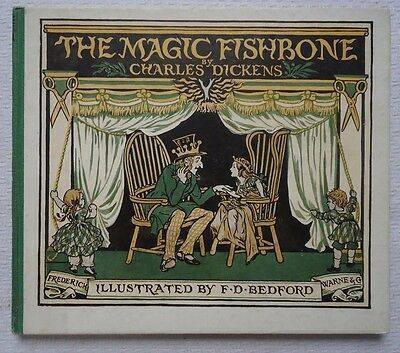
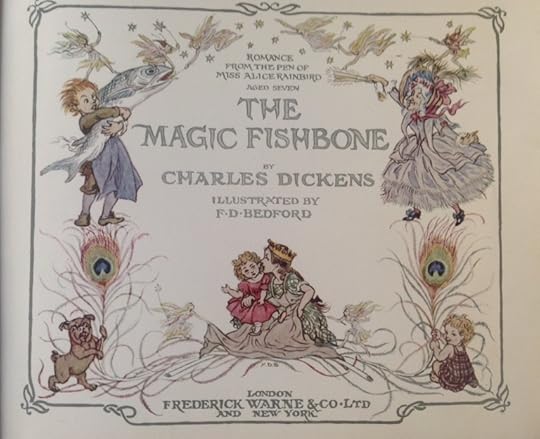
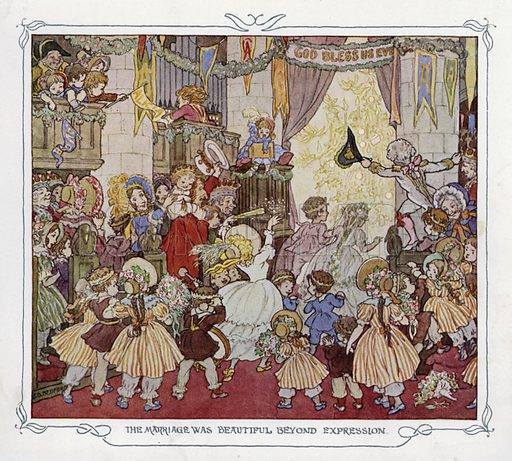

Although they are a little later than those by Susan Beatrice Pearse, I think I prefer them. The whimsical humour of the king feels just right. He's just an ordinary Victorian man here, as Robin said, except for his ridiculous crown :D He is somewhere between the working and middle class; the surroundings in the final picture could either be a working man's home, but overall it feels like a middle class Victorian kitchen. But decidedly not aristocracy!
The moppets by Susan Beatrice Pearse are cute, but not amusing in the same way. They are similar to the illustrations by Mabel Lucie Attwell, who illustrated nursery rhymes primarily, (but also Mabel Lucie Attwell's Peter Pan and Wendy) whereas Francis D. Bedford often seemed to illustrate fairy tales.




Although they are a little later than those by Susan Beatrice Pearse, I think I prefer them. The whimsical humour of the king feels just right. He's just an ordinary Victorian man here, as Robin said, except for his ridiculous crown :D He is somewhere between the working and middle class; the surroundings in the final picture could either be a working man's home, but overall it feels like a middle class Victorian kitchen. But decidedly not aristocracy!
The moppets by Susan Beatrice Pearse are cute, but not amusing in the same way. They are similar to the illustrations by Mabel Lucie Attwell, who illustrated nursery rhymes primarily, (but also Mabel Lucie Attwell's Peter Pan and Wendy) whereas Francis D. Bedford often seemed to illustrate fairy tales.
 Yes, I like this one a lot, because of the more "realistic" scenes. The wedding scene of course is different because everyone has entered fairyland then. It used to be a type of entertainment or performance for children to act out weddings, outfits and all.
Yes, I like this one a lot, because of the more "realistic" scenes. The wedding scene of course is different because everyone has entered fairyland then. It used to be a type of entertainment or performance for children to act out weddings, outfits and all.
 I read a copy with F.D.Bedford 's illustrations which were a total delight to look at closely. One of the reasons I enjoy reading books for children is that I adore the accompanying art.
I read a copy with F.D.Bedford 's illustrations which were a total delight to look at closely. One of the reasons I enjoy reading books for children is that I adore the accompanying art.
Me too Lori!
Thanks Robin, for suggesting and hosting this enjoyable read; it made a refreshing change!
I'll leave this thread in our current reads for a few days, as our main read won't start until mid-February.
Thanks Robin, for suggesting and hosting this enjoyable read; it made a refreshing change!
I'll leave this thread in our current reads for a few days, as our main read won't start until mid-February.
 It was my pleasure and I'll try to remember for next year that I would like to lead The Holly-Tree Inn.
It was my pleasure and I'll try to remember for next year that I would like to lead The Holly-Tree Inn.
message 35:
by
Bionic Jean, "Dickens Duchess"
(last edited Feb 02, 2021 07:14AM)
(new)
-
rated it 5 stars
Thank you Robin - and yes I'll definitely pencil that in! We'll need to be a lot nearer the time to get the actual dates, and make sure it suits - and also a time scale for either three or seven parts - but it's a very welcome offer :)
At last I have found time to put fingers to keyboard and write a review of this charming story. Here it is:
The Magic Fishbone by Charles Dickens ⭐⭐⭐⭐⭐
Jean's review
The Magic Fishbone by Charles Dickens ⭐⭐⭐⭐⭐
Jean's review
Books mentioned in this topic
The Magic Fishbone (other topics)The Holly-Tree (other topics)
Peter Pan and Wendy (other topics)
The Hundred Dresses (other topics)
The Hundred Dresses (other topics)
More...
Authors mentioned in this topic
Charles Dickens (other topics)Susan Beatrice Pearse (other topics)
Mabel Lucie Attwell (other topics)
Francis Donkin Bedford (other topics)
Susan Beatrice Pearse (other topics)
More...




Reading and discussion begins on January 16th, and lasts for two weeks until the end of January. Please allow Robin to comment first - thanks!